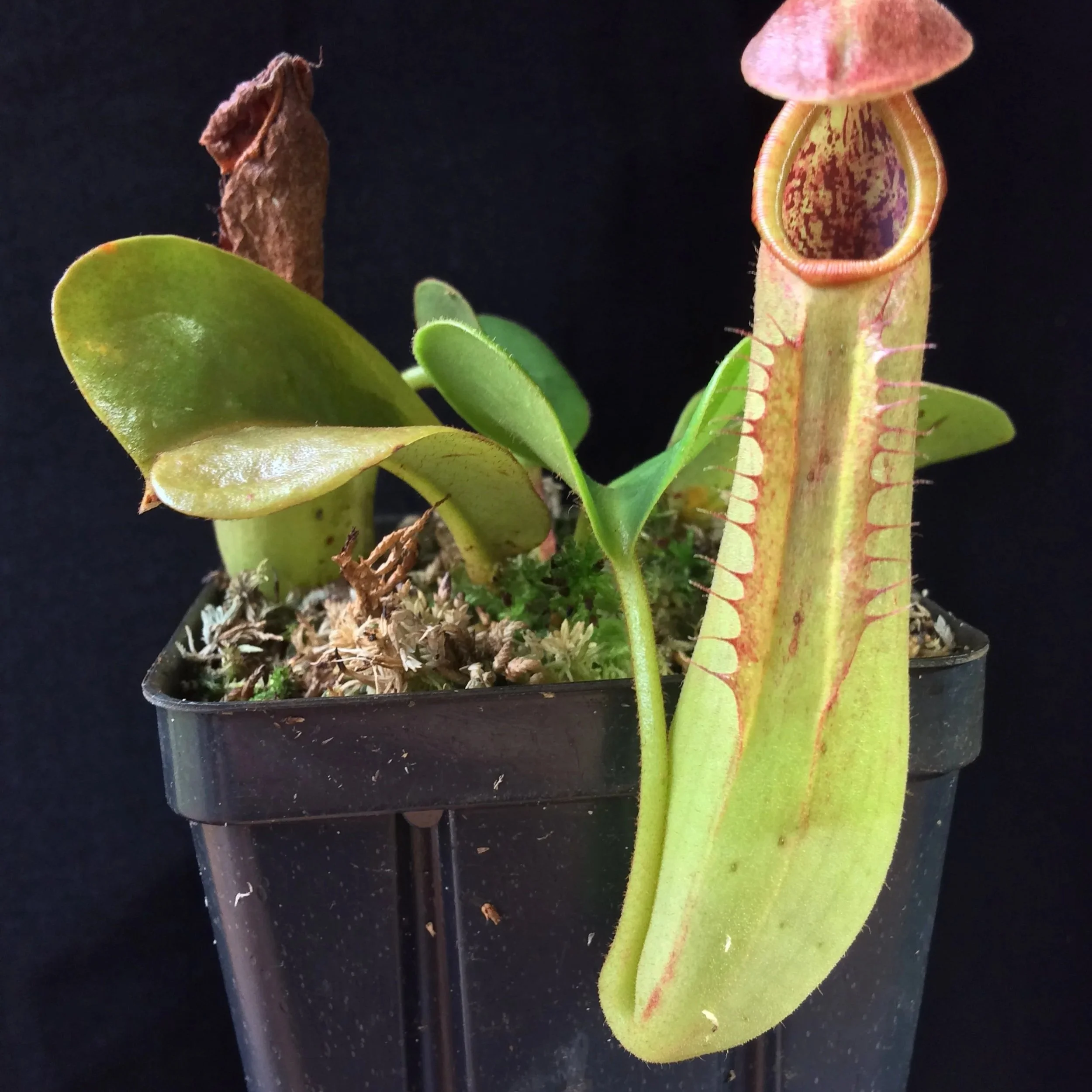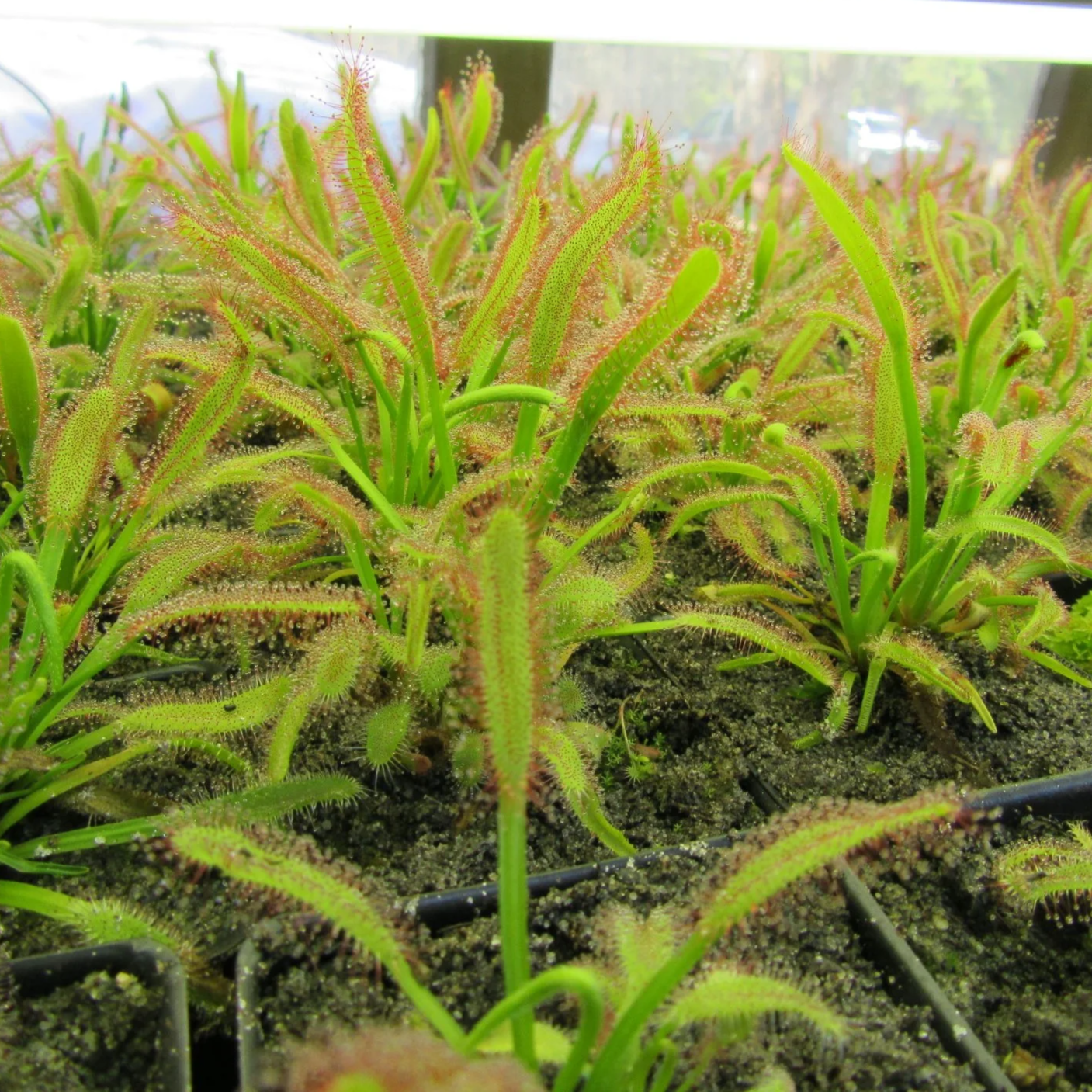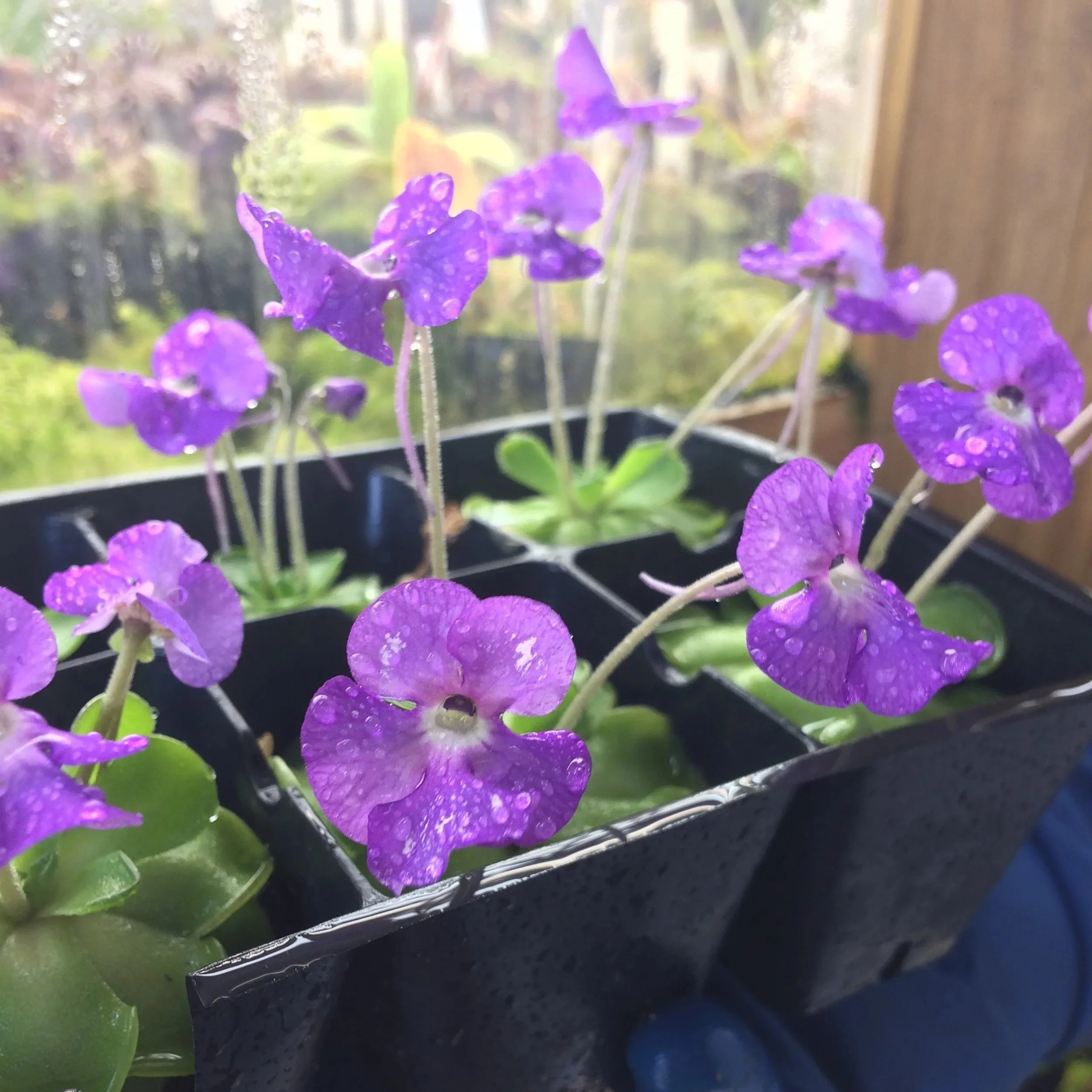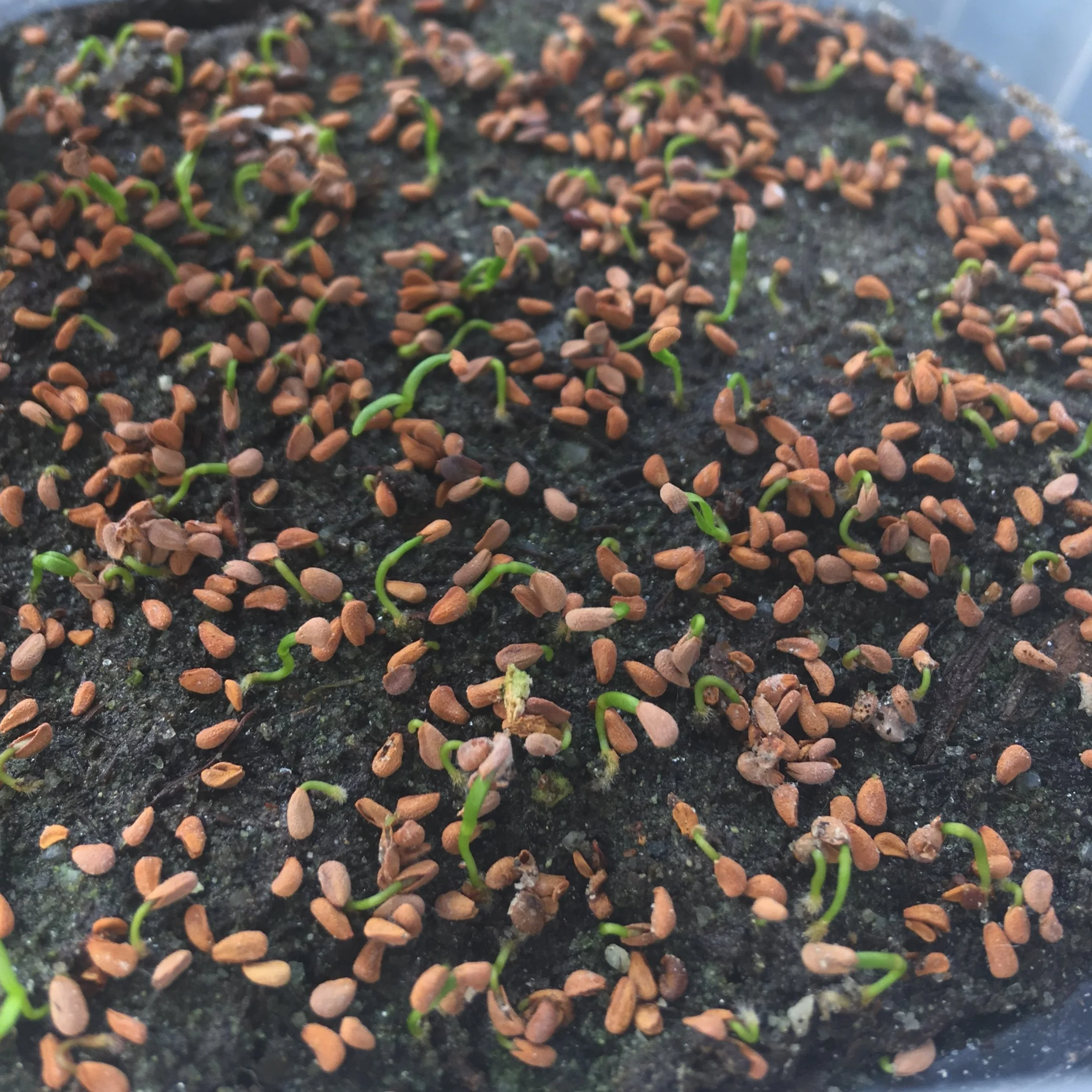Nepenthes truncata
Tropical Pitcher Plant - Nepenthes
Also called “Monkey Cups”, these tropical plants are native to southeastern Asia. They grow well as house plants as long as they receive ample amount of light to produce their exquisite pitchers. Artificial light can be beneficial especially in winter time to keep them happy and producing their traps.
SUN: Provide part sun, or a minimum of three hours of direct light. If any burning occurs, move to lower light and slowly acclimate to higher light. Nepenthes need sufficient light to produce pitchers.
WATER: Use rain, distilled, or reverse osmosis water. Keep soil moist! Place the pot in a shallow saucer and water overhead as soon as the water in the saucer evaporates. Don't let the pot sit in water for extended periods (can cause root rot). Wicking/African violet pots are helpful for worry free watering
TEMPERATURE AND DORMANCY: The Nepenthes we sell will do well in average household temperatures unless otherwise noted. Protect from temperatures below 45 *F
SOIL: Nepenthes are tolerant of a wide variety of soil mixes, so long as they are acidic and nutrient poor. A good standard mix is one part long fibered sphagnum moss to one part perlite.
FERTILIZER/FEEDING: 1/4 strength orchid fertilizer can be applied to the leaves and inside the pitchers once every couple weeks. You can also place 2-3 Osmocote plus outdoor/indoor pellets into the soil near the base of the plant every six months until they attain a larger size. They are not fond of large amounts of soil fertilization. Flush soil through with fresh water periodically if soil is fertilized.
Drosera capensis
Tropical Sundews - Drosera
Sundews come in many sizes and shapes but some are much hardier and forgiving. Watering is super easy on these; always standing on a saucer of (rain/purified/ro-) water. Fungus gnats, fruit flies and house flies are mainly on their dinner plate.
Where to Grow: Many tropical sundews can be quite adaptable. A sure-fire way to keep them is indoors as a tropical houseplant on a sunny windowsill. Regardless of where you grow them, always protect tropical sundews from freezing temperatures.
Sunlight: Provide partial sunlight (several hours of direct sunlight with bright filtered light the remainder of the day). Avoid full shade. Excessive sun can burn them if they arent adjusted to it. Most tropical species can be acclimated to more extreme heat and longer hours of direct sun over time, but many prefer cooler temperatures provided indoors during the summer.
Artificial Lights: If a sunny window is not possible, you can use daylight spectrum LED fixtures with the lights approximately 12 inches above the plant.
Water: All sundews require mineral-free water. If your tap water is relatively pure (less than 50 parts per million in dissolved minerals), then you can safely water your sundews with it. Otherwise, you can use rain, distilled, or reverse osmosis bottled water. Keep the soil wet at all times. You can do this by setting the plant in small amounts of standing water, up to halfway up the pot.
Soil and fertilization: Use a 1:1 mix of peat moss and perlite. Never use potting soil, compost or fertilizer; they will kill your plant. They can be fed small insects or moistened blood worms from the pet store.
Sarracenia leucophylla
Venus Flytrap, US Native Pitcher Plants - Sarracenia, Native Sundews
Apparently rarely seen in full glory; these natives boast in full sun. Just not in our garden soil! Feeding is not necessary as they are so effective in catching their own food they will start to suffer from indigestion come late fall!
SUN: Provide at least 6 hours of direct sun. They grow best outdoors, but they can be grown indoors on a very sunny windowsill or under grow lights. They appreciate some afternoon shade in extreme heat. Keep them as potted plants, they will not survive planted in regular yard soil.
WATER: Always keep them sitting in a saucer with a few inches of water. Only use rain, distilled, or reverse osmosis water. Do not let them dry out. Rain barrel would be a great investment!
TEMPERATURE AND DORMANCY: These are warm-temperate plants, needing warm summers and chilly winters. Winter dormancy is a necessity. Plants will naturally slow growth and go dormant in the fall. Pitchers and dead leaves can be cut back at this time. Make sure they stay wet in the winter as well, especially during a freeze. If temperatures dip below the low 20’s Fahrenheit it is advisable to offer them protection. At our nursery we cover them with a plastic tarp during hard freezes. Mulching with six or more inches of pine straw will provide greater protection. Or, you can put them in a dark and cold area that offers protection from extreme cold, such as a garage or enclosed patio for the winter
SOIL: Roughly 50/50 mix of fertilizer free peat moss with perlite or clean silica sand. Check the fine print. DO NOT use soil ingredients with added fertilizers! Avoid Miracle grow brand.
FEEDING AND FERTILIZER: They catch their own nutrition when outdoors. No need to fertilize!
Pinguicula cyclosecta
Butterworts -Pinguicula
SUN: Provide part sun, or a minimum of three hours of direct light. If burning occurs, move to lower light and slowly acclimate to higher light. Butterworts produce more colorful and sticky foliage in bright light.
WATER: Use rain, distilled, or reverses osmosis water. Keep soil moist! Place the pot in a shallow saucer and water overhead as soon as the water in the saucer evaporates. Don't let the pot sit in water for extended periods (can cause root rot). Wicking/African violet pots are helpful for worry free watering
TEMPERATURE AND DORMANCY: The butterworts we sell will do well in average household temperature. Protect from frost. Many tropical butterworts transition to succulent, non-carnivorous leaves for a few months once a year before producing sticky leaves again.
SOIL: Tropical butterworts enjoy a well-draining, nutrient poor soil. Our favorite mix is 1 part each of course vermiculite, perlite, silica sand, and peat moss. Don’t use regular potting soil.
FERTILIZER/FEEDING: 1 /4 strength orchid fertilizer can be sprayed on the leaves once every couple weeks. They are not fond of large amounts of soil fertilization. They will feed on fungus gnats, springtails, and other similarly sized creatures.
How to Grow Sarracenia pitcher plants from seed
Seeds that we sell are dry, and if you are not planning on sowing them immediately we recommend keeping in fridge for extended viability. Once the seeds are exposed to moisture they need to be stratified. Sarracenia seeds need cold and moist stratification in order to start sprouting.
You can fill a small plastic ziplock pouch with water and just add your seeds in there. Close the bag and press the contents to help wet the seeds.
Put the bag in the fridge for 4 weeks.
Sprinkle the seeds on top of the suitable, pre-wetted soil. The seeds can not be buried as they need light in order to sprout!
Put the pot sitting in a tray of rainwater, distilled or ro water. Never let dry.
Expect the seeds to start sprouting within a month or two depending on the soil temperature




